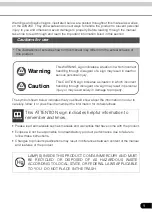
6
FRONT PANEL CONTROLS
Front Panel Controls
7
Surround Mode Group Selector:
Press
this button to select the top-level group of sur-
round modes. Each press of the button will
select a major mode grouping in the following
order:
Dolby Modes
➜
DTS Digital Modes
➜
DSP
Modes
➜
Stereo Modes
➜
Logic 7 Modes
Once the button is pressed so that the name of
the desired surround mode group appears in the
Lower Display Line
Ú
, press the
Surround
Mode Selector
#
to cycle through the indi-
vidual modes available. For example, press this
button to select Dolby modes, and then press
the
Surround Mode Selector
#
to choose
from the various mode options.
8
Tuning Selector:
Press the left side of the
button to tune lower frequency stations and the
right side of the button to tune higher frequency
stations. When a station with a strong signal is
reached,
MANUAL TUNED
or
AUTO
TUNED
will appear in the
Main Information
Display
Ú
(see page 25 for more information
on tuning stations).
9
Tuner Band Selector:
Pressing this button
will automatically switch the AVR to the Tuner
mode. Pressing it again will switch between the
AM and FM frequency bands, holding it pressed
for some seconds will switch between stereo
and mono receiving and between automatic and
manual tuning mode (See page 25 for more
information on the tuner).
)
Preset Stations Selector:
Press this
button to scroll up or down through the list of
stations that have been entered into the preset
memory. (See page 25 for more information on
tuner programming.)
!
Input Source Selector:
Press this button
to change the input by scrolling through the list
of input sources.
@
RDS Select Button:
Press this button to dis-
play the various messages that are part of the
RDS data system of the AVR’s tuner. (See page 26
for more information on RDS).
#
Surround Mode Selector:
Press this but-
ton to select from among the available surround
mode options for the mode group selected. The
specific modes will vary based on the number of
speakers available, the mode group and if the
input source is digital or analog. For example,
press the
Surround Mode Group Selector
7
to select a mode grouping such as Dolby or
Logic 7, and then press this button to see the
mode choices available. For more information on
mode selection, see page 22.
$
Surround Mode Indicators:
A blue LED
will light in front of the surround mode that is
currently in use.
%
Remote Sensor Window:
The sensor
behind this window receives infrared signals
from the remote control. Aim the remote at this
area and do not block or cover it
.
^
Bass Control:
Turn this control to modify the
low frequency output of the left/right channels by
as much as ±10dB. Set this control to a suitable
position for your taste or room acoustics.
&
Balance Control:
Turn this control to
change the relative volume for the front
left/right channels.
NOTE:
For proper operation of the surround
modes this control should be at the midpoint or
“12 o’clock” position.
*
Treble Control:
Turn this control to modify
the high frequency output of the left/right chan-
nels by as much as ±10dB. Set this control to a
suitable position for your taste or room acoustics.
(
Volume Control:
Turn this knob clockwise
to increase the volume, counterclockwise to
decrease the volume. If the AVR is muted,
adjusting volume control will automatically
release the unit from the silenced condition.
Ó
Set Button:
When making choices during
the setup and configuration process, press this
button to enter the desired setting as shown in
the
Main Information Display
Ú
into the
AVR’s memory. The set button may also be used
to change the display brightness. (See page 25.)
Ô
Input indicators:
A blue LED will light in
front of the input that is currently being used as
the source for the AVR.
Delay:
Press this button to begin the
sequence of steps required to enter delay time
settings. (See page 18 for more information on
delay times.)
Ò
Digital Input Selector:
When playing a
source that has a digital output, press this
button to select between the
Optical
and
Coaxial
Digital
inputs. (See pages
22-24 for more information on digital audio.)
Ú
Main Information Display:
This display
delivers messages and status indications to help
you operate the receiver.
Û
Channel Select Button:
Press this button
to begin the process of trimming the channel
output levels using an external audio source.
(For more information on output level trim
adjustment, see page 24.)
Ù
Speaker Select Button:
Press this button
to begin the process of selecting the speaker
positions that are used in your listening room.
(See page 15 for more information on setup and
configuration.)
ı
Digital Optical 3 Input:
Connect the opti-
cal digital audio output of an audio or video prod-
uct to this jack. When the Input is not in use, be
certain to keep the plastic cap installed to avoid
dust contamination that might degrade future
performance.
ˆ
Digital Coax 3 Input:
This jack is normally
used for connection to the output of portable
digital audio devices, video game consoles or
other products that have a coax digital jack.
˜
Video 3 Input Jacks:
These audio/video
jacks may be used for temporary connection to
video games or portable audio/video products
such as camcorders and portable audio players.
¯
Speaker/Channel Input Indicators:
These
indicators are multipurpose, indicating either the
speaker type selected for each channel or the
incoming data-signal configuration. The left, cen-
ter, right, right surround and left surround speaker
indicators are composed of three boxes, while the
subwoofer is a single box. The center box lights
when a “Small” speaker is selected, and the two
outer boxes light when “Large” speakers are
selected. When none of the boxes are lit for the
center, surround or subwoofer channels, no
speaker has been selected for that position. (See
page 15 for more information on configuring
speakers.) The letters inside each of the center
boxes display active input channels. For standard
analog inputs, only the L and R will light, indicat-
ing a stereo input. When a digital source is play-
ing, the indicators will light to display the chan-
nels begin received at the digital input. When the
letters flash, the digital input has been interrupt-
ed. (See page 15 for more information on the
Channel Indicators).







































